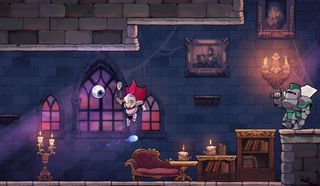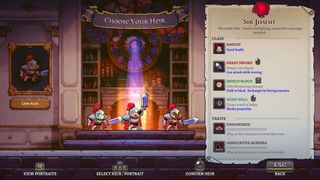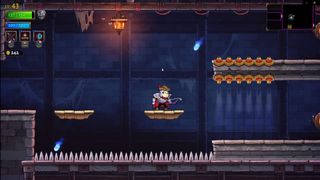Rogue Legacy 2's brutal platforming drags down the action
The Early Access launch is light on the unlockable upgrades that make Rogue Legacy a joy to progress through.

Mistiming a jump, I clatter into a hulking brute in a suit of armor. I fall backwards, managing to bail out before I hit the spike trap below, but not quickly enough to dodge an incoming firebolt from a very angry floating wizard. The screen fades to black, and my unfortunate protagonist—the short-sighted Lady Alex—shrugs in my direction before giving up the ghost.
It’s been nearly six years since I last played Rogue Legacy, and in many ways playing the sequel I feel like I’ve never been away. It’s almost instantly recognisable, from the endearingly clunky combat to its cheeky sense of humour. The central narrative premise remains unchanged: Each time the roguelite claims the life of your hero, one of your heirs takes up the mantle. After frittering away your inheritance (aka the money you earned on your previous run) on whatever upgrades they can afford, your successor heads off to make their own fortune, and almost certainly perish in the process.
It doesn’t take long before the family tree stretches far above the tallest redwood, but Rogue Legacy 2 differentiates between characters in two ways. Firstly, by class: There are sword-wielding warriors and barbarians whose axes hit like trucks, fragile but hard-to-reach rangers, and mages with an arsenal of spells up their sleeves. Each character might also have a ‘trait’, a genetic attribute passed down to them that might impact their visual appearance, their combat abilities, or even what appears on the screen.
‘Divas’, for example, spend their lives in the spotlight, the areas around them almost entirely blacked out. ‘Clumsy’ characters immediately destroy any object they touch, while ‘Pacifists’ can’t deal any damage whatsoever. A few traits are simply visual, but they bring a touch of charm to otherwise nondescript runs. A personal favourite is Synesthesia, which causes any moving object to leave behind a trail of colour, transforming rooms into vibrant, Pollock-esque tapestries.
Despite their supposedly genetic connection, traits are acquired at random. Most grant bonuses to the amount of gold you can accrue, and the bonus scales with their level of inconvenience. If you’re fortunate enough to grab the right trait for the right class, you can gain a significant advantage in battle. The more ‘Bookish’ members of the family make perfect mages, gaining massive spell damage and mana reserves at the cost of their martial capabilities; a barbarian with ‘Hollow Bones’ falls slowly, granting them easier access to their useful air attack. Entertaining as traits can be, however, I can’t help but feel a little uncomfortable at some of the jokes that they’re used to facilitate. Several make light of genuine medical conditions—dwarfism, glaucoma, OCD—in a way that feels out of touch in 2020. It seems clumsy rather than malicious, but it's something this sequel could've avoided.

While much of Rogue Legacy 2 sticks closely to the original, there are a few significant updates. A cartoonish art style replaces the original pixel art, with swish new animations that make combat feel faster and cleaner, and imbue many of the enemy types with far more personality than their predecessors offered.
Another major change is the arrival of rooms dedicated to platforming instead of combat. These rooms look like they’ve been inspired by Celeste or Super Meat Boy—spike- or flame-filled gauntlets offer a chest full of coin if you’re prepared to risk the damage you’ll take if you slip up.
The biggest gaming news, reviews and hardware deals
Keep up to date with the most important stories and the best deals, as picked by the PC Gamer team.
It’s an interesting concept, but at least in this Early Access release, the platforming doesn't fit. Rogue Legacy 2 is missing the precision that good platformers require. Character models are bulky and not as well-defined as they should be, making it more difficult to accurately land tricky jumps. Air control is decent, but the generous gravity on your way up feels punishing on the way down. Several rooms feel as though they’ve been designed with cruelty rather than mechanical mastery in mind.

This is a game that thrives when it leans into its effortless sense of pace, but so often Rogue Legacy 2 needs a slow, methodical approach. The "legacy" system is meant to lighten the tension of dying found in more permanent roguelikes—death comes fast, but you can easily pick yourself back up and start again. But when you die because you can’t weave your way through a gauntlet you'll never get a chance to practice, or because you fell into a pit of spikes so far below you that you had no possible way to known they were there, picking yourself up and starting again feels a little harder each time.
In its current state, Rogue Legacy 2 is also missing much of what I'd expect to give the final game longevity. It took less than five hours to earn enough money to unlock almost every upgrade included in the current build, rendering money meaningless and ensuring I’d ignore challenges completely, focusing instead on rushing to meaningful long-term objectives. The second stage of the game is missing entirely—there's an in-game developer note explaining its absence and encouraging players to move on to chapter three, an area of the game that the current stat boosts can’t equip you for. Right now Rogue Legacy 2 is unfinished in an unusually visible way, which drains away the momentum of its mostly successful first few hours.
If you played its predecessor, Rogue Legacy 2 will feel instantly familiar. A new art style and some new monsters don’t hide what was, and often remains, a slick, fast-paced roguelite with an endearing narrative hook, even if the frustrating platforming is an unwelcome addition. For now the game’s biggest issue is that large chunks of it simply aren't there. The sparse release means Rogue Legacy 2 just doesn't have the depth it needs to compete with my favorite roguelikes.
Most Popular

